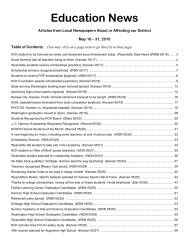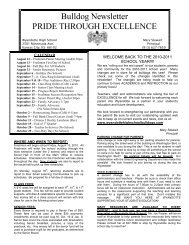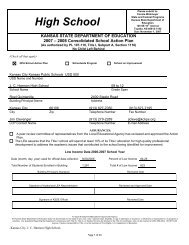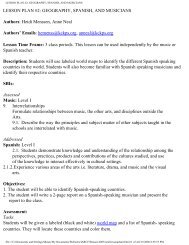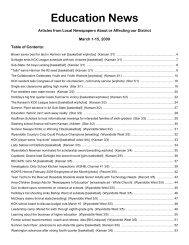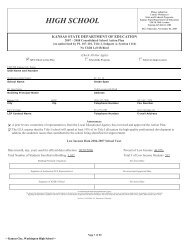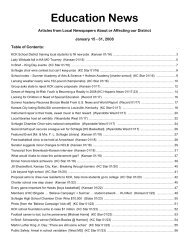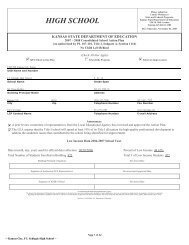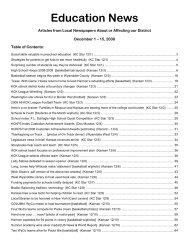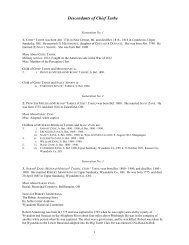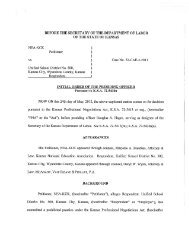Chapter V - Kansas City, Kansas Public Schools
Chapter V - Kansas City, Kansas Public Schools
Chapter V - Kansas City, Kansas Public Schools
Create successful ePaper yourself
Turn your PDF publications into a flip-book with our unique Google optimized e-Paper software.
"SILVER CITY," A History of the Argentine Community of <strong>Kansas</strong> <strong>City</strong>, <strong>Kansas</strong> by Edwin Dale Shutt, II (Copyright 1976) – <strong>Chapter</strong> 5<br />
forces and many of these men would proudly write back that they had seen ships bearing the markings of the<br />
<strong>Kansas</strong> <strong>City</strong> Structural Steel Company. 46<br />
Large numbers of boats built by the steel plant were used in the Allied invasion of Sicily. The United<br />
States Navy was so pleased with the performance of the company’s boats that a personal letter was written to<br />
the company’s President, H. A. Fitch. The letter read as follows:<br />
It will be a matter of personal pride to each of you to know that LCT’s of your<br />
construction were part of the spearhead in the successful invasion of Sicily. The fact that the<br />
landing operations on a scale unparalleled in history, were effected with the utmost precision<br />
and a minimum of casualties was in no small measure due to the efficient performance of the<br />
landing craft such as you are providing for our amphibious forces. Many more of your LCT’s will<br />
be needed for the bigger job ahead when our fighting boys establish the beachheads which will<br />
ultimately lead to Berlin and to Tokyo. They are counting on your best effort to supply these<br />
vital crafts on time. 47<br />
Cordially yours,<br />
Rear Admiral E. L. Cochran<br />
Chief of the Bureau of Ships<br />
The author was fortunate enough to have the opportunity to interview two retired employees of the<br />
company who had some part in the construction of these boats. C. T. Campbell had these recollections:<br />
Frank Schafer, a pattern and templates maker, was probably the genius behind their<br />
construction. “Whitey” Hufferd 48 and Leonard Cramer were the foremen over the construction.<br />
For most of the war, the plant was run on two shifts of ten hours. Security was very tight. There<br />
were guards posted at the gates. Naval personnel supervised the construction. All employees<br />
had to wear badges with their pictures on them which they had to show swhenever they entered<br />
and left the plant. 49<br />
Glen L. Culp, a retired area foreman remembered the following about the war years:<br />
The shop was divided up into a north and a south end. Small boats were built in the<br />
north end and the larger boats were built in the south end. The boats were fabricated in the<br />
plant. Then they were hauled over to the boatyards on the Missouri River west of the Fairfax<br />
Airport. The smaller landing crafts were hauled from the steel plant to the boat dock on large<br />
trailer trucks. The larger boats, I believe, were floated down the river to the boat dock. There,<br />
the boats were outfitted with plumbing, electrical and mechanical equipment and then launched.<br />
Some of the boats were launched at Fairfax and were floated down the Missouri and Mississippi<br />
Rivers to New Orleans. Other oats were loaded onto railroad cars. Almost one boat was turned<br />
out every three days. The <strong>Kansas</strong> <strong>City</strong> Structural Steel Company received many Army and<br />
Navy awards for its accomplishments. 50<br />
During the war, a bridge in China fabricated by the company gave the <strong>Kansas</strong> <strong>City</strong> Structural Steel<br />
Company another kind of publicity. This three-span bridge over the Pei Ho River near Tienstin, China, was<br />
considered an engineering feat when it was constructed. The Japanese claimed to have destroyed it several<br />
times. However, a former employee of the company, in the service as a Navy Lieutenant, sent Mr. Fitch a<br />
photograph of the bridge, showing troops crossing it well after the Japanese reports of its destruction. 51 This<br />
picture hung in his office for many years. The bridge apparently survived the war.<br />
46 <strong>Kansas</strong> <strong>City</strong> Star, August 4, 1946, p. 8D<br />
47 <strong>Kansas</strong> <strong>City</strong>, <strong>Kansas</strong>, August 20, 1944, p. 3<br />
48 Manuel W. Hufferd gave over fifty years of service to the company. He was the author’s great uncle.<br />
49 Cornelius T. Campbell, personal interview held in his home at 1501 Ruby, <strong>Kansas</strong> <strong>City</strong>, <strong>Kansas</strong> on March 12, 1974.<br />
50 Glen L. Culp, personal interview held in his home at 2514 S. 49 Terrace, <strong>Kansas</strong> <strong>City</strong>, <strong>Kansas</strong> on February 25, 1974.<br />
51 <strong>Kansas</strong> <strong>City</strong> Star, August 4, 1946, p. 8D



